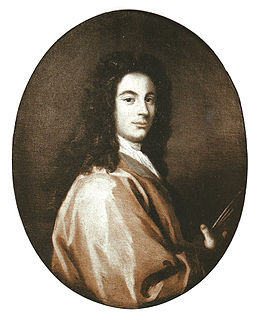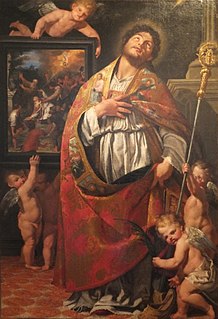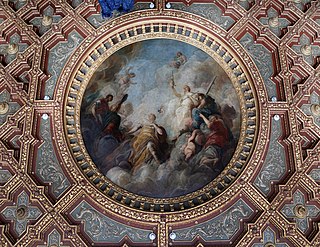
Giovanni Battista Mengardi, or Giambattista Mengardi (7 October 1738, Padua - 28 August 1796, Venice) was an Italian painter and art restorer.

Giovanni Battista Mengardi, or Giambattista Mengardi (7 October 1738, Padua - 28 August 1796, Venice) was an Italian painter and art restorer.
He had his first art lessons in Padua; continuing in Venice, where he was able to study with Giambattista Tiepolo, who had just returned from Würzburg. He then became a member of the "Brotherhood of Painters", in Padua, where he created his first major work; decorations in the Episcopal chapel, to mark the beatification of Cardinal Gregorio Barbarigo (1761). They have since been lost. He would remain in Padua until 1767. That year, after painting some frescoes at the Palazzo Maldura, he left to live in Venice, where he enrolled at the Academy of Fine Arts.
His initial project there involved paintings for the Chiesa di San Pietro Apostolo in Campagna Lupia. In the 1770s, he created an altarpiece, depicting the Holy Family, for the sanctuary at San Geremia.
He became a Professor at the Academy in 1776. Two years later, he was appointed an inspector for the Council of Ten, succeeding the late Antonio Maria Zanetti, and was charged with maintaining a census of pictorial works on public display. The following year, his duties were divided, with Pietro Edwards being put in charge of general restoration. These responsibilities had the predictable effect of reducing his artistic output.
In 1787, he decorated the ceilings in four rooms at the Palazzo Priuli in Cannaregio with mythological subjects, including Athena contending with Poseidon over the possession of Attica. At Sant'Andrea, Padua church, he painted the ceiling with the Apotheosis of St Andrew. His last major commissions were executed between 1792 and 1793: a fresco for the ceiling at the Palazzo Barbarigo della Terrazza, depicting Vulcan delivering the sword of Aeneas to Venus, and a grisaille fresco in simulated relief, at the Palazzo Bellavite Baffo.
| Wikimedia Commons has media related to Giovanni Battista Mengardi . |

Giovanni Battista Tiepolo, also known as GiambattistaTiepolo, was an Italian painter and printmaker from the Republic of Venice who painted in the Rococo style, considered important member of the 18th-century Venetian school. He was prolific, and worked not only in Italy, but also in Germany and Spain.

Luca Giordano was an Italian late-Baroque painter and printmaker in etching. Fluent and decorative, he worked successfully in Naples and Rome, Florence, and Venice, before spending a decade in Spain.

Pietro da Cortona was an Italian Baroque painter and architect. Along with his contemporaries and rivals Gian Lorenzo Bernini and Francesco Borromini, he was one of the key figures in the emergence of Roman Baroque architecture. He was also an important designer of interior decorations.

Ca' Rezzonico is a palazzo on the Grand Canal in the Dorsoduro sestiere of Venice, Italy. It is a particularly notable example of the 18th century Venetian baroque and rococo architecture and interior decoration, and displays paintings by the leading Venetian painters of the period, including Francesco Guardi and Giambattista Tiepolo. It is a public museum dedicated to 18th-century Venice and one of the 11 venues managed by the Fondazione Musei Civici di Venezia.

Giovanni Lanfranco was an Italian painter of the Baroque period.

Carlo Maratta or Maratti was an Italian painter, active mostly in Rome, and known principally for his classicizing paintings executed in a Late Baroque Classical manner. Although he is part of the classical tradition stemming from Raphael, he was not exempt from the influence of Baroque painting and particularly in his use of colour. His contemporary and friend, Giovanni Bellori, wrote an early biography on Maratta.

Sebastiano Ricci was an Italian painter of the late Baroque school of Venice. About the same age as Piazzetta, and an elder contemporary of Tiepolo, he represents a late version of the vigorous and luminous Cortonesque style of grand manner fresco painting.

Antonio Balestra was an Italian painter of the Rococo period.

Giuseppe Angeli was an Italian painter of the late-Baroque, known for depicting both genre and religious subjects.

Italian Renaissance painting is the painting of the period beginning in the late 13th century and flourishing from the early 15th to late 16th centuries, occurring in the Italian Peninsula, which was at that time divided into many political states, some independent but others controlled by external powers. The painters of Renaissance Italy, although often attached to particular courts and with loyalties to particular towns, nonetheless wandered the length and breadth of Italy, often occupying a diplomatic status and disseminating artistic and philosophical ideas.

Giuseppe Alberti was an Italian painter of the Baroque period. He was born at Cavalese, in what was then Austrian Tyrol. After having studied medicine at Padua he decided to become a painter and architect. He worked under Pietro Liberi in Venice, then in Rome, and finally settled at Trieste. Alberti died at Cavalese.

Venetian painting was a major force in Italian Renaissance painting and beyond. Beginning with the work of Giovanni Bellini and his brother Gentile Bellini and their workshops, the major artists of the Venetian school included Giorgione, Titian, Tintoretto (1518–1594), Paolo Veronese (1528–1588) and Jacopo Bassano (1510–1592) and his sons. Considered to give primacy of colour over line, the tradition of the Venetian school contrasted with the Mannerism prevalent in the rest of Italy. The Venetian style exerted great influence upon the subsequent development of Western painting.

Italian Baroque art is a term that is used here to refer to Italian painting and sculpture in the Baroque manner executed over a period that extended from the late sixteenth to the mid eighteenth centuries.

Ettore Tito was an Italian artist particularly known for his paintings of contemporary life and landscapes in Venice and the surrounding region. He trained at the Accademia di Belle Arti in Venice and from 1894 to 1927 was the Professor of Painting there. Tito exhibited widely and was awarded the Grand Prize in painting at the 1915 Panama–Pacific International Exposition in San Francisco. In 1926 he was made a member of the Royal Academy of Italy. Tito was born in Castellammare di Stabia in the province of Naples and died in Venice, the city which was his home for most of his life.

The Palazzo Barbarigo Minotto is a 15th-century palace on the Grand Canal in Venice, northern Italy, next to the much larger Palazzo Corner. Built in the Venetian Gothic style, it was originally two palaces, Palazzo Barbarigo and Palazzo Minotto, later joined together. The Barbarigo palace was owned by the Barbarigo family for several centuries and was the birthplace of Gregorio Barbarigo, who once refused the Papal Crown. It was later owned by the Minotto and Martinengo families.

Francesco Alberi was an Italian Neoclassical style painter, active in Bologna, Padua, Rimini and Rome.
Gerolamo Mengozzi Colonna was an Italian painter, mostly of frescoed quadratura.

Giovanni De Min was an Italian painter and engraver, active in a Neoclassic style.

Fabio Canal or Canale was an Italian painter of the late Baroque era, active mainly depicting history and sacred subjects in his native Venice.

Costantino Cedini was an Italian painter and art professor.